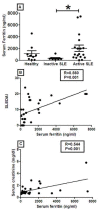Inflammation associated anemia and ferritin as disease markers in SLE
- PMID: 22871034
- PMCID: PMC3580577
- DOI: 10.1186/ar4012
Inflammation associated anemia and ferritin as disease markers in SLE
Abstract
Introduction: In a recent screening to detect biomarkers in systemic lupus erythematosus (SLE), expression of the iron storage protein, ferritin, was increased. Given that proteins that regulate the storage, transfer and release of iron play an important role in inflammation, this study aims to determine the serum and urine levels of ferritin and of the iron transfer protein, transferrin, in lupus patients and to correlate these levels with disease activity, inflammatory cytokine levels and markers of anemia.
Methods: A protein array was utilized to measure ferritin expression in the urine and serum of SLE patients and healthy controls. To confirm these results as well as the role of the iron transfer pathway in SLE, ELISAs were performed to measure ferritin and transferrin levels in inactive or active SLE patients and healthy controls. The relationship between ferritin/transferrin levels and inflammatory markers and anemia was next analyzed.
Results: Protein array results showed elevated ferritin levels in the serum and urine of lupus patients as compared to controls, which were further validated by ELISA. Increased ferritin levels correlated with measures of disease activity and anemia as well as inflammatory cytokine titers. Though active SLE patients had elevated urine transferrin, serum transferrin was reduced.
Conclusion: Urine ferritin and transferrin levels are elevated significantly in SLE patients and correlate with disease activity, bolstering previous reports. Most importantly, these changes correlated with the inflammatory state of the patients and anemia of chronic disease. Taken together, altered iron handling, inflammation and anemia of chronic disease constitute an ominous triad in SLE.
Figures






References
-
- Da Costa R, Szyper-Kravitz M, Szekanecz Z, Csepany T, Danko K, Shapira Y, Zandman-Goddard G, Orbach H, Agmon-Levin N, Shoenfeld Y. Ferritin and prolactin levels in multiple sclerosis. Isr Med Assoc J. 2011;13:91–95. - PubMed
-
- Yildirim K, Karatay S, Melikoglu MA, Gureser G, Ugur M, Senel K. Associations between acute phase reactant levels and disease activity score (DAS28) in patients with rheumatoid arthritis. Ann Clin Lab Sci. 2004;34:423–426. - PubMed
Publication types
MeSH terms
Substances
LinkOut - more resources
Full Text Sources
Medical

